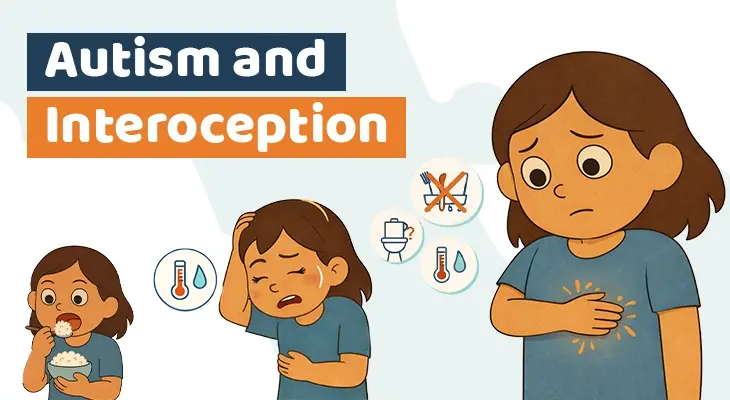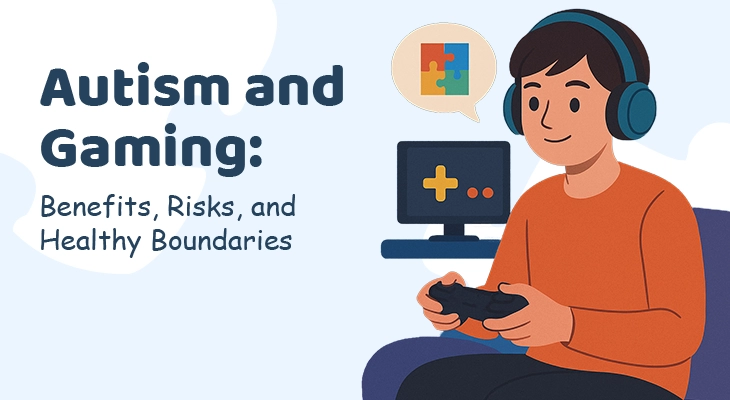Introduction
Autism spectrum disorder (ASD) affects millions of people worldwide, but there’s a concerning disparity in diagnoses between genders. While the currently accepted ratio of males to females with ASD is around 4:1, a growing body of research suggests this might be significantly skewed.
This blog delves into the critical issue of underdiagnosis of autism in girls. We’ll explore the potential reasons behind this disparity and its implications for the mental health and well-being of young women on the spectrum.
Autism in Girls: The Diagnostic Bias
Diagnostic bias is one reason why autism in girls is more likely to be misdiagnosed, underdiagnosed, or diagnosed later in life. Diagnostic bias refers to the unintentional delay or missing of a diagnosis by an examining physician. This occurs because while autism can present differently in girls and boys, the typical lens of symptoms has been focused on the way autism presents in boys.
Shining a light on the issue of diagnostic bias, a thought-provoking article by Maia Szalavitz titled “Autism—It’s Different in Girls” appears in Scientific American. Szalavitz uses the example of Frances, a young girl who displayed early developmental delays but was not diagnosed with autism until age five. Despite her father being a leading autism researcher, societal expectations of what autism looks like in girls (social, happy) led to missed diagnoses and a focus on alternative explanations for her delays. This story exemplifies the challenges girls with autism face and the crucial need for a more inclusive approach to diagnosis.
Let’s deep dive into the reasons that contribute to diagnostic bias.
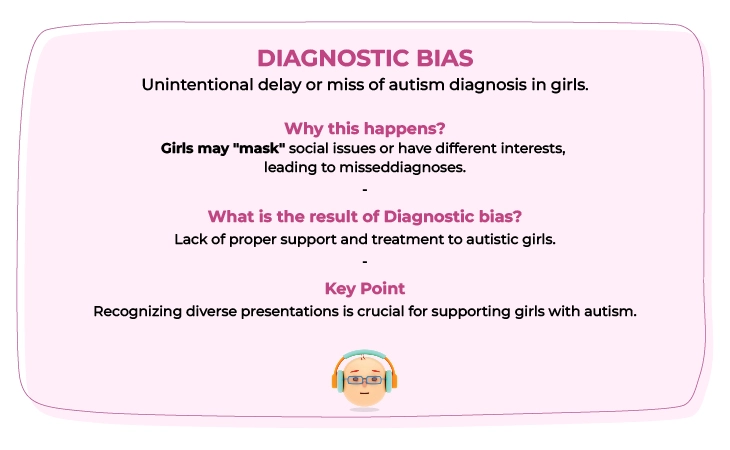
Download Download & share this Knowledge card in your network [Free Download]
Autism in Girls: Less Repetitive Behaviors, Higher Risk of Miss
The traditional image of autism often centers on exhibiting repetitive behaviors like hand-flapping or fixations on specific interests. However, a groundbreaking study from Stanford University suggests girls with autism might present differently.
The study found girls with high-functioning autism displayed less repetitive and restricted behaviors compared to boys. This could be a significant factor contributing to underdiagnosis in girls.
Why does this happen?
This happens due to brain structure differences. Girls and boys with autism showed distinct brain structural differences, particularly in areas related to motor function and planning. This could explain the variations in repetitive behaviors.
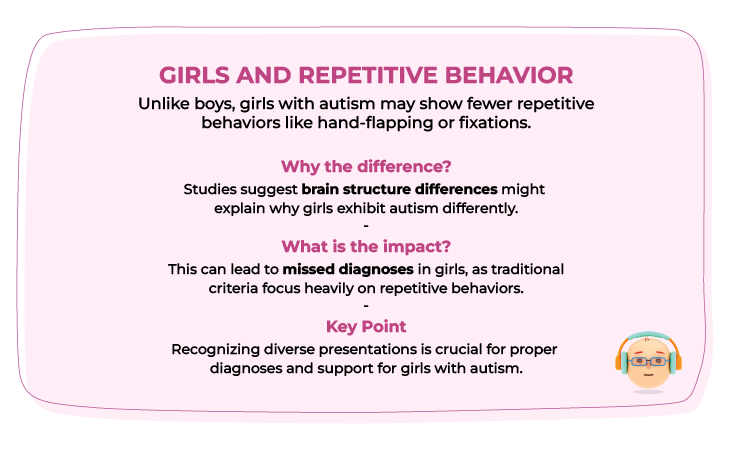
Download Download & share this Knowledge card in your network [Free Download]
Autism in Girls: Missed Diagnoses Due to Social Masking
A poignant quote from a young woman with ASD perfectly encapsulates the problem: “The amount of girls that aren’t diagnosed because they are more likely to camouflage than boys is really bad. I went for so long without being diagnosed because they didn’t know that I could pretend to be normal!”
This statement highlights the key challenge: girls with autism are often adept at “masking” their symptoms. They may mimic social behaviors they observe in others, appearing more neurotypical and leading to missed diagnoses. Traditional diagnostic criteria, based primarily on how autism presents in boys, might overlook the unique ways autism manifests in girls.
The Story of Jennifer O'Toole
Maia Szalavitz’s article in Scientific American highlights the challenges of diagnosing autism in girls through the story of Jennifer O’Toole. Despite outwardly appearing “normal” (cheerleader, sorority girl), O’Toole hid her autistic traits remarkably well. This ability to mimic social behavior is a prime example of masking in girls with autism. O’Toole describes needing to study people and social interactions like others might study math, highlighting the significant effort girls put into appearing neurotypical. This masking behavior can make it challenging to diagnose autism in girls, as traditional methods often rely on readily observable symptoms.
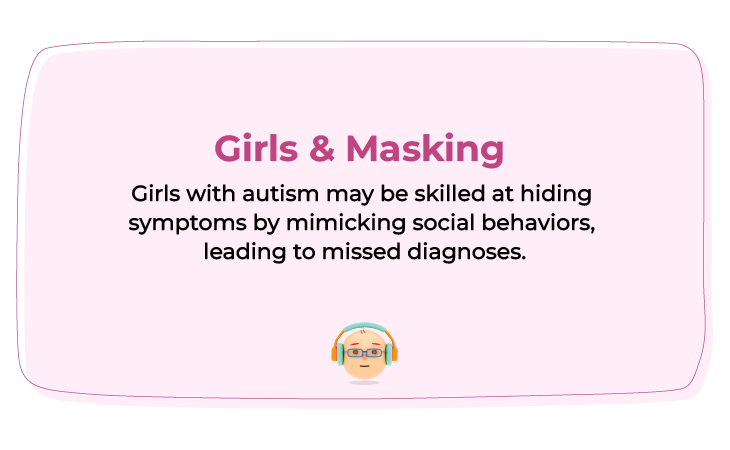
Download Download & share this Knowledge card in your network [Free Download]
Autism in Girls: Missed Diagnoses Due to Behavior
Society’s expectations often blur the lines when diagnosing autism in girls. Traditional ideas of autistic behaviors might overlap with what’s considered “normal” for girls. For instance, while a boy’s Intense, repetitive interests in subjects like dinosaurs might be readily identified as a potential sign of autism, a young girl’s intense interest in a popular princess character or a teenager’s fascination with a particular celebrity could be dismissed as a typical phase. However, this intense focus might actually be a sign of rigid thinking, a core feature of autism. This mix-up can lead to missed diagnoses in girls on the spectrum.
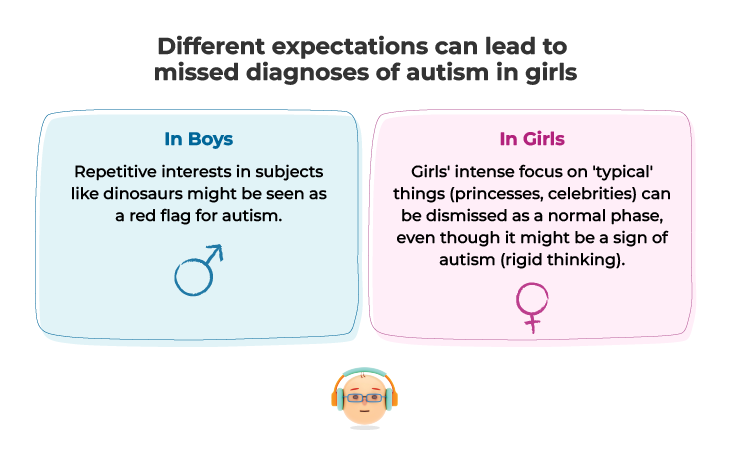
Download Download & share this Knowledge card in your network [Free Download]
The Gender Gap in Autism Diagnosis: Time to Revise the Tools?
Historically, research focused on white males, shaping the very tools used to diagnose autism today. Researchers are now questioning whether these tools accurately capture the autistic experience for girls. Theories, and experiences as explained in this blog, suggest these differences could involve:
- Overlooking “typical” interests: Girls’ intense focus on seemingly “normal” things, like princesses or celebrities, might be misconstrued as a phase rather than a sign of autism.
- Masking behaviors: Girls may learn to mimic social cues more readily, allowing their true struggles to go unnoticed.
- Misdiagnosis of co-occurring conditions: Rigid thinking, a hallmark of autism, might be mistaken for anxiety, depression, or eating disorders – conditions more commonly diagnosed in women.
The Hidden Struggles of Misdiagnosed Girls
Missed diagnoses can have a significant negative impact on the mental well-being of girls with autism. Here’s how:
- Lack of Support: Without a diagnosis, girls may not receive the support they need to manage their autistic traits. This can lead to feelings of isolation, frustration, and confusion.
- Mental Health Issues: Missed diagnoses can contribute to the development of co-occurring mental health conditions like anxiety, depression, and low self-esteem. These girls may struggle to understand their own experiences and may feel like they’re “failing” to meet social expectations.
- Sense of Identity: An autism diagnosis can provide a sense of identity and help explain some of the challenges girls face. Without a diagnosis, they may feel like something is wrong with them but not know why.
- Delayed Intervention: Early intervention is crucial for helping girls with autism develop social skills, manage sensory sensitivities, and learn coping mechanisms. Missed diagnoses can delay this critical intervention, potentially impacting their overall development and quality of life.
Conclusion
The journey towards understanding autism in girls is ongoing, but the message is clear: the traditional image of autism is incomplete.
This blog has explored the reasons behind the underdiagnosis of autism in girls, highlighting the challenges of diagnostic bias, masking behaviors, and societal expectations.
By recognizing the diverse ways autism manifests, we can ensure girls on the spectrum receive the support and understanding they deserve.
References
- “Putting on My Best Normal”: Social Camouflaging in Adults with Autism Spectrum Conditions
- Stanford Medicine, Girls and boys with autism differ in behavior, brain structure
- National Library of Medicine | Finding the True Number of Females with Autistic Spectrum Disorder by Estimating the Biases in Initial Recognition and Clinical Diagnosis
- Autism Speaks | Autism in Girls & Women



